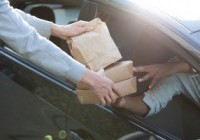Amazon.com, GrubHub Under Fire From Uber Restaurant Delivery
Ride-booking firm Uber announced in a blog post Tuesday that it was expanding its restaurant delivery service and spinning it off from the main Uber mobile app. Called UberEats, the food delivery app will add competitive pressure to Amazon.com ( AMZN ) and GrubHub ( GRUB ), both of which have competing restaurant delivery offerings. GrubHub stock was down 5% in early afternoon trading in the stock market today , while Amazon stock was flat. UberEats is an expansion of the company’s “instant delivery” service, which offers a fixed menu and deliveries in “as little as 10 minutes.” UberEats is partnering with “hundreds” of restaurants to make food delivery available seven days a week, according to the company’s blog. Cowen analyst Kevin Kopelman conducted tests of UberEats in Santa Monica, Calif., and found that the app’s estimates — 30 minutes or less, with a midpoint around 11 minutes — beat Amazon Prime Now Restaurants’ nationwide average of 39 minutes. GrubHub does not provide precise timing information because it doesn’t make the delivery itself, Kopelman pointed out in a research note Monday. Amazon offers estimates “within the hour.” Kopelman says that UberEats has changed to curbside delivery only, which means that drivers will not meet customers at the door, as is the norm in food delivery. Kopelman says that changing to curbside lets the company more easily integrate existing drivers for UberX — its taxi-like service, where drivers use personal cars to ferry passengers — which the firm is using as a primary source for delivery recruitment. An Uber spokeswoman told IBD that the company’s “instant delivery” is curbside, but she added that its regular restaurant delivery “in most cases” is door-to-door. Unlike Amazon and GrubHub, UberEats does not allow tipping within the app — though customers can give the driver a cash tip — and its fees are among the lowest among its competitors, according to Kopelman. Amazon does not charge a delivery fee, at least for now. “Our initial impressions of UberEats in Los Angeles make us incrementally more cautious on the competitive environment for GrubHub,” Kopelman wrote. The UberEats app and curbside restaurant delivery are set to roll out in Chicago, Houston, Los Angeles, San Francisco and Toronto, according to the company’s blog. Seven other major markets are set to open “around the corner” — including Melbourne, New York and Paris. Troubled Market But if startups are any indication, then UberEats, Amazon and GrubHub are vying for a market that is looking at a troubled future. Tuesday, TechCrunch reported that SpoonRocket, a food delivery app, is shutting down amid the “on-demand apocalypse,” referring to the big challenges of the food deliveries business. And Monday, the Wall Street Journal published a report saying that grocery delivery app Instacart, valued at over $2 billion, is slashing its driver pay 63% in a bid for profitability. The WSJ also pointed out that such on-demand delivery companies are attempting to avoid repeating history. In the dot-com bust, heralded grocery delivery startup Webvan Group burned through $800 million before shutting down in 2001.
